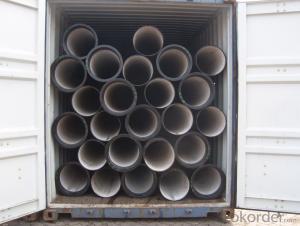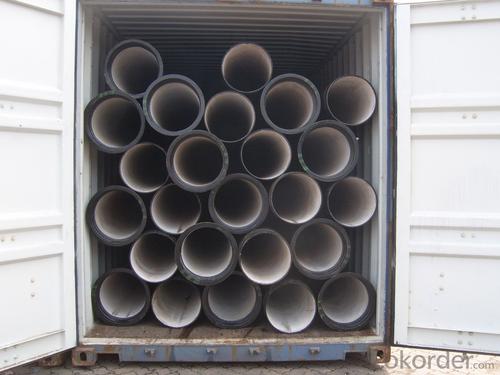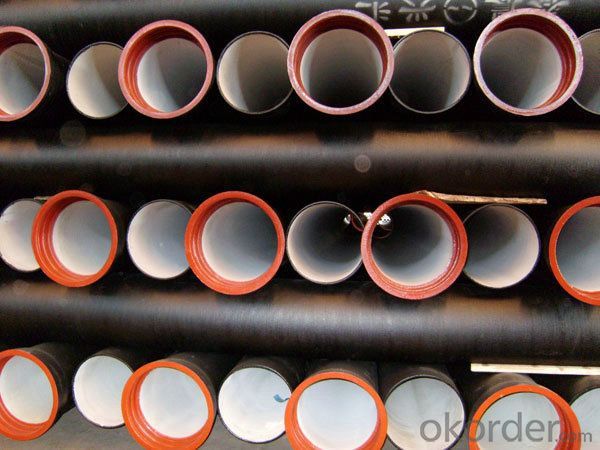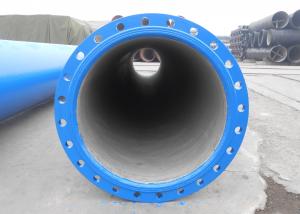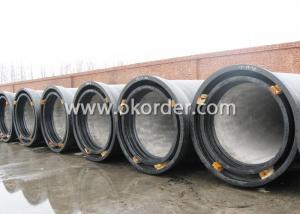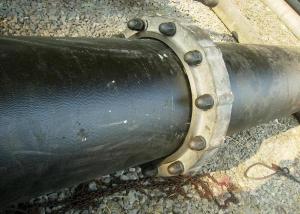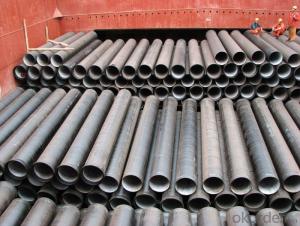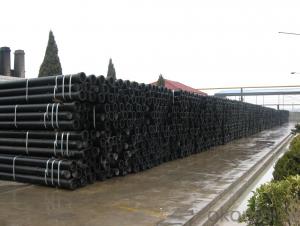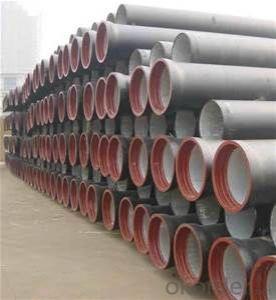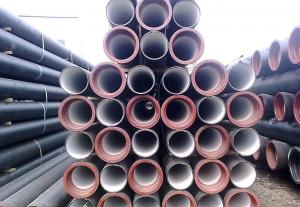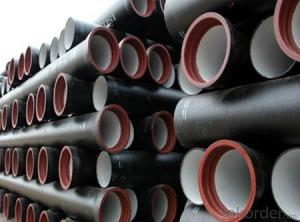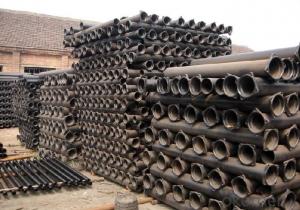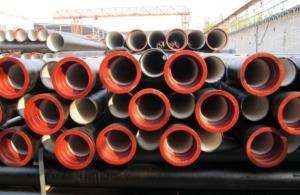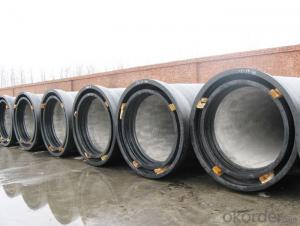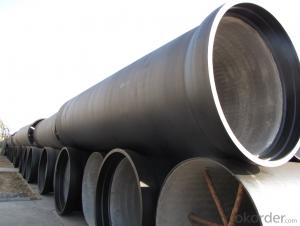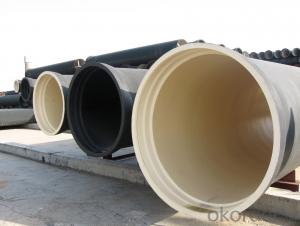Ductile Iron Pipe High Quality EN598 K8 DN2400
- Loading Port:
- China main port
- Payment Terms:
- TT OR LC
- Min Order Qty:
- 999 m
- Supply Capability:
- 9999 m/month
OKorder Service Pledge
OKorder Financial Service
You Might Also Like
1,Ductile Iron Pipe Description :
1) Pipes confirm to ISO2531,K9 class,T type joint,6m long,with inside cements lining conform to ISO4179, outside Zinc spraying(130g/m2) and bitumen coating(70μm) conform to ISO8179.
2) Pipe ends: Spigot and socket ends, with 100% SBR rubber gaskets accoding to ISO4633
3) we can do third party inspection according to customer's request.
4) Our products have been sold to many international market, such as Middle East and South East Asia and Africa.
2,Main Features of the Ductile Iron Pipe:
•High yield strength
•High tensile Strength
•High corrosion resistance
•Pressure Resistence
•Satisfy the highest hygienic standards
Material: Ductile iron grade 500-7/ 450-10 in accordance with ISO1083
Standard: ISO 2531, EN545, EN598, ANSI, AWWA
3,Ductile Iron Pipe Images:
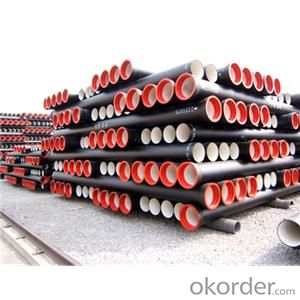
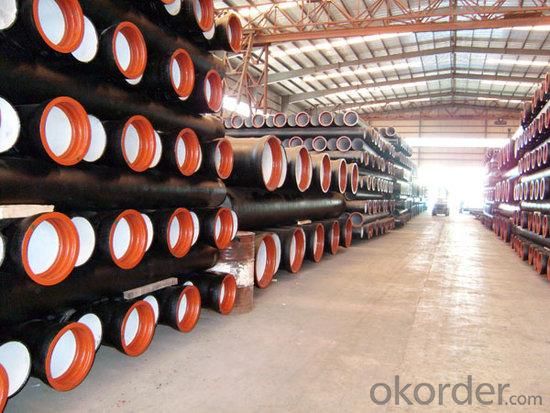
4. Ductile Iron Pipe Specification
1.Standard: API SPEC 5L 44th eidtion,ASTM A252-98(2007)
2.Grade: A53 Grades A/B, ASTM A106 Grades B/C,ASTM A179
AWWA, C200, ASTM A139, ASTM A120, API 5L Grade B
X42, X52, X56, X60, X65, X70, X80, X100
3.Weld Alternatives: LSAW
4.OD size range: 6.4~44.5mm
5.Wall thickness: 406.4~1422mm
6.Length: 3 - 12 m according to requirment
5.FAQ:
We have organized several common questions for our clients,may help you sincerely:
1.Q: Why would you choose ductile iron pipe rather than other pipe materials?
A:The reasons are obvious for that not only ductile iron pipe possesses the inherent strength and flexibility of ductile iron, combined with proven corrosion protection systems, but also the cost savings can be achieved from design to installation and commissioning.
2.Q:Why can you guarantee the inner of pipes can’t be corroded?
A: High alumina cement mortar lining and sulphate-resistant cement mortar lining. These two special linings are applicable to inner anti-corrosion for sewage pipes, improving resistance to erosion of the sewage components.
- Q: Can ductile iron pipes be used for underground steam distribution systems?
- Yes, ductile iron pipes can be used for underground steam distribution systems. Ductile iron is a type of cast iron that has been treated with magnesium to make it more flexible and resistant to cracking. This makes it suitable for use in underground applications where the pipes may need to withstand high pressure and temperature conditions, such as in steam distribution systems. Ductile iron pipes have excellent strength and durability, which makes them capable of handling the extreme conditions associated with steam distribution. Additionally, their corrosion resistance properties make them a reliable choice for long-term use in underground environments. However, it is important to note that proper insulation should be used to prevent heat loss and ensure the efficiency of the steam distribution system.
- Q: Can ductile iron pipe be used for horizontal directional drilling?
- Yes, ductile iron pipe can be used for horizontal directional drilling (HDD). HDD is a trenchless method of installing underground utilities, such as pipelines, without the need for traditional open-cut trenching methods. Ductile iron pipe is often used in HDD projects due to its strength, durability, and ability to withstand the stresses and strains associated with directional drilling. It has excellent resistance to external loads and can withstand the bending and pulling forces involved in HDD installations. However, it is important to consider factors such as pipe diameter, wall thickness, and soil conditions to ensure proper pipe selection for HDD projects. Additionally, proper installation techniques and precautions should be followed to ensure the long-term performance and integrity of the ductile iron pipe in HDD applications.
- Q: How are ductile iron pipes protected against external soil loads?
- Ductile iron pipes are protected against external soil loads through a combination of proper installation techniques and the use of protective coatings. The pipes are installed in a manner that allows for adequate support and backfilling, which helps distribute the external soil loads evenly. Additionally, these pipes are often coated with materials such as epoxy or polyethylene to provide a barrier between the pipe and the surrounding soil, preventing corrosion and damage from external forces. This protective coating ensures the longevity and durability of ductile iron pipes in underground applications.
- Q: Ductile iron pipe converter, steel transition DN100 turn 100, what is the specific accessories name? Can you supply photos?
- 1. corrosion resistance: in addition to some strong oxidizing substances, polyethylene material pipe fittings can effectively prevent oxidation material corrosion.2., leakage prevention: the use of hot melt and electric melting technology, the pipe interface can be tightly linked together, there is no leakage.
- Q: Can ductile iron pipes be used for trench crossings?
- Yes, ductile iron pipes can be used for trench crossings. Ductile iron pipes are known for their high strength and durability, making them suitable for a wide range of applications including trench crossings. They have the ability to withstand heavy loads and external pressures, making them an ideal choice for underground installations. Additionally, ductile iron pipes have excellent corrosion resistance properties, ensuring their longevity and reliability in trench crossing scenarios.
- Q: What are the common methods for leak detection in ductile iron pipes?
- Some common methods for leak detection in ductile iron pipes include visual inspection, acoustic leak detection, pressure testing, and tracer gas leak detection. Visual inspection involves physically inspecting the pipes for any visible signs of leaks, such as water stains or wet spots. Acoustic leak detection uses specialized equipment to listen for sounds of leaking water within the pipes. Pressure testing involves pressurizing the pipes to a certain level and checking for any drop in pressure, which could indicate a leak. Tracer gas leak detection involves injecting a gas, such as helium or hydrogen, into the pipes and using a gas detector to locate any escaping gas, which would indicate a leak.
- Q: Can ductile iron pipe be used for underground storage tank systems?
- Yes, ductile iron pipe can be used for underground storage tank systems. Ductile iron is a strong and durable material that is resistant to corrosion and can withstand the pressure and load requirements of underground storage systems.
- Q: Is nodular cast iron pipe filled with Yau Ma Tei?
- In many areas of our country, ductile iron pipe in the middle and small diameter to tube connected with the tube, the bearing type or flange interface method; ductile iron, angle limit must be allowed better seismic performance and sealing performance.
- Q: How does ductile iron pipe perform in areas with high water hammer?
- Ductile iron pipe performs exceptionally well in areas with high water hammer. The strength and durability of ductile iron allow it to withstand the forceful impact of water hammer without any significant damage. Water hammer refers to the sudden increase in pressure caused by the rapid change in water flow direction or velocity, often occurring when valves are closed quickly. This abrupt change in pressure can lead to significant stress on pipes, potentially causing them to rupture or fail. However, ductile iron pipes have excellent impact resistance due to their unique composition and manufacturing process. They are made from a combination of iron, carbon, and small amounts of other elements such as silicon and magnesium. The graphite nodules formed during the manufacturing process give ductile iron its superior strength and flexibility, making it less prone to cracking or breaking under pressure. In areas with high water hammer, ductile iron pipe's inherent strength and resilience allow it to absorb and dissipate the force generated by water hammer events. Its ability to withstand the sudden pressure changes helps to prevent pipe failure, minimizing the risk of leaks or bursts. Additionally, the smooth internal surface of ductile iron pipes reduces the likelihood of water hammer occurrences by minimizing turbulence and maintaining a more constant flow. This characteristic helps to mitigate the impact of water hammer on the pipe system. Overall, ductile iron pipe is an ideal choice for areas with high water hammer due to its exceptional strength, impact resistance, and ability to withstand sudden pressure changes. Its performance in such conditions ensures the longevity and reliability of the water distribution system.
- Q: Advantages and disadvantages of ductile iron pipes
- The ductile iron pipe is widely used not only in foreign countries, and has also been in the country to promote the use of good, in many areas of our country, ductile iron pipe has been widely used in medium and small diameter water supply pipe; compare the performance of ductile iron pipe and steel pipe: steel pipe can be divided into seamed steel pipe and seamless in the water supply pipe, commonly used in welded tube. Compared with ductile iron pipes, the steel tube has the advantages of good toughness, high tensile strength, thin tube wall, high pressure resistance, long pipes and less interfaces. The biggest drawback is that the corrosion resistance is poor and the price is high. So, in general, except for small bore pipes and special projects (such as pipe jacking works);
Send your message to us
Ductile Iron Pipe High Quality EN598 K8 DN2400
- Loading Port:
- China main port
- Payment Terms:
- TT OR LC
- Min Order Qty:
- 999 m
- Supply Capability:
- 9999 m/month
OKorder Service Pledge
OKorder Financial Service
Similar products
Hot products
Hot Searches
Related keywords
